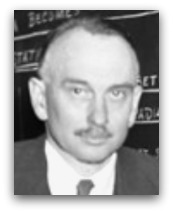Richard TOLMAN (1881 - 1948) was an American mathematical physicist and physical chemist who was a top class scientist in
many areas, mainly in statistical mechanics, cosmology, condensed matter physics and theoretical physics. He made
important contributions to theoretical cosmology in the years soon after Einstein's discovery of general
relativity. He was a professor of physical chemistry and mathematical physics at the California Institute of Technology,
PASADENA, CA.
Richard TOLMAN studied chemical engineering at the Massachusetts Institute of Technology, receiving his bachelor's
degree in 1903 and Ph.D. in 1910.
In 1912, he coined the concept of relativistic mass by writing that "the expression m0(1 - v2/c2)-1/2 is best
suited for THE MASS of a MOVING BODY."
In a 1916 experiment, Tolman definitively proved that electricity consists of electrons flowing through a metallic
conductor. A by-product of this experiment was a measured value of the MASS of the electron. Overall, however, he
was primarily known as a theorist.
Tolman was elected a Fellow of the American Academy of Arts and Sciences in 1922. The same year, he joined the faculty
of the California Institute of Technology, where he became professor of physical chemistry and mathematical physics, and
later dean of the graduate school. An early student of Tolman's at Caltech was the American theoretical chemist
Linus Pauling, to whom he taught the pre-wave-mechanics quantum theory.
In 1927, Tolman published a book on statistical mechanics whose background was the old quantum theory of Max Planck,
Niels Bohr, and Arnold Sommerfeld.
In 1938, he published a completely new fundamental book, The Principles of Statistical Mechanics,
covering in detail the application of statistical mechanics to both
classical and quantum systems. It was become the standard reference text on the subject for many years,
and is still of great interest today, because it gives a clearest and detailed presentation of the Gibbs'
Statistical Mechanics.
In the later years of his career, Tolman became increasingly interested in the application of thermodynamics to
relativistic systems, and
cosmology, work that culminated in an important 1934 monograph, Relativity, Thermodynamics, and Cosmology. That
monograph showed that black body radiation in an expanding universe cools
but remains thermal, an important result for the properties of the cosmic microwave background.
Last years of his life he worked on the oscillatory universe hypothesis, which Einstein had proposed in 1930.
In his theories, Tolman supposedly introduces the theory that as the entropy of the universe rises, so do the universe cycle sizes and
lengths tend to grow. Tolman’s cosmological cycles theories are employed by Paul Davies.
During World War II, he served as scientific advisor to General Leslie Groves on the Manhattan Project.
At the time of his death in Pasadena, he was chief advisor to Bernard Baruch, the U.S. representative to the
United Nations Atomic Energy Commission.
Each year, the southern California section of the American Chemical Society honors Tolman by awarding its
Tolman Medal "in recognition of outstanding contributions to chemistry."
Books by R. Tolman:
* Statistical mechanics with applications to physics and chemistry. New York: The Chemical Catalog Company. 1927.
* Relativity, Thermodynamics, and Cosmology. Oxford: Clarendon Press. 1934. LCCN 340-32023.
Reprinted (1987) New York: Dover Publications. ISBN 0-486-65383-8.
* The Principles of Statistical Mechanics. Oxford: Clarendon Press. 1938.
Reprinted (1979) New York: Dover ISBN 0-486-63896-0.
There are a few places where the biography of Richard TOLMAN can be found.
Wikipedia electronic Encyclopedia(http://en.wikipedia.org/) ,
an article Richard TOLMAN.
BIOGRAPHY of Richard TOLMAN and Guide to
the Papers of Richard Chase Tolman.
http://www.eoht.info/page/Richard+Tolman
